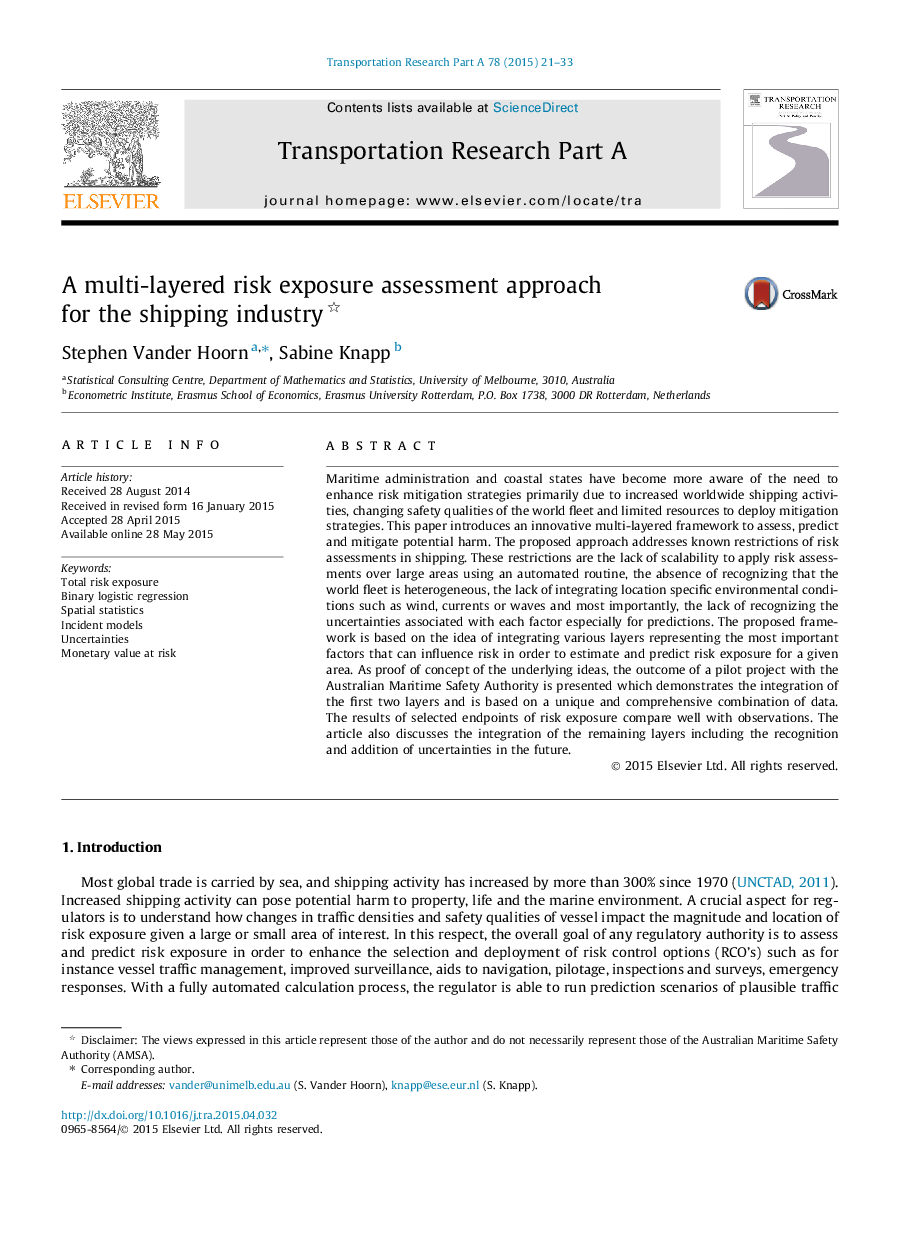| کد مقاله | کد نشریه | سال انتشار | مقاله انگلیسی | نسخه تمام متن |
|---|---|---|---|---|
| 6781212 | 533940 | 2015 | 13 صفحه PDF | دانلود رایگان |
عنوان انگلیسی مقاله ISI
A multi-layered risk exposure assessment approach for the shipping industry
ترجمه فارسی عنوان
یک روش ارزیابی خطرات چند لایه برای صنعت حمل و نقل
دانلود مقاله + سفارش ترجمه
دانلود مقاله ISI انگلیسی
رایگان برای ایرانیان
کلمات کلیدی
کل خطر در معرض، رگرسیون لجستیک باینری، آمار فضایی، مدل های حادثه، عدم اطمینان، ارزش پولی در معرض خطر،
ترجمه چکیده
دولت دریایی و دولت های ساحلی بیشتر از نیاز به افزایش استراتژی های کاهش خطر در درجه اول به دلیل افزایش فعالیت های حمل و نقل در سراسر جهان، تغییر کیفیت ایمنی ناوگان جهانی و منابع محدود برای استقرار استراتژی های کاهش است. این مقاله چارچوبی نوین چند لایه را برای ارزیابی، پیش بینی و کاهش آسیب بالقوه معرفی می کند. رویکرد پیشنهادی به محدودیت های شناخته شده ارزیابی ریسک در حمل و نقل اشاره دارد. این محدودیت ها فقدان مقیاس پذیری برای ارزیابی ریسک در مناطق بزرگ با استفاده از یک روال خودکار است، فقدان شناخت اینکه ناوگان جهانی ناهمگن است، عدم وجود محیط های محیطی خاص مانند باد، جریان یا امواج و مهمتر از همه، عدم شناخت عدم قطعیت های مربوط به هر عامل به ویژه برای پیش بینی ها. چارچوب پیشنهادی بر مبنای ایده ی ادغام لایه های مختلف نشان دهنده مهم ترین عوامل است که می تواند بر ریسک تاثیر بگذارد تا برآورد و پیش بینی مخاطره در یک منطقه مشخص شود. به عنوان مدرک مفهوم ایده های پایه، نتیجه یک پروژه آزمایشی با اداره ایمنی دریایی استرالیا ارائه شده است که نشان دهنده ادغام دو لایه اول است و بر اساس یک ترکیب منحصر به فرد و جامع از داده ها است. نتایج حاصل از نتایج انتخاب شده در معرض خطر به خوبی با مشاهدات مقایسه می شود. این مقاله همچنین در مورد ادغام لایه های باقی مانده از جمله شناسایی و اضافه شدن عدم قطعیت در آینده بحث می کند.
موضوعات مرتبط
مهندسی و علوم پایه
سایر رشته های مهندسی
مهندسی عمران و سازه
چکیده انگلیسی
Maritime administration and coastal states have become more aware of the need to enhance risk mitigation strategies primarily due to increased worldwide shipping activities, changing safety qualities of the world fleet and limited resources to deploy mitigation strategies. This paper introduces an innovative multi-layered framework to assess, predict and mitigate potential harm. The proposed approach addresses known restrictions of risk assessments in shipping. These restrictions are the lack of scalability to apply risk assessments over large areas using an automated routine, the absence of recognizing that the world fleet is heterogeneous, the lack of integrating location specific environmental conditions such as wind, currents or waves and most importantly, the lack of recognizing the uncertainties associated with each factor especially for predictions. The proposed framework is based on the idea of integrating various layers representing the most important factors that can influence risk in order to estimate and predict risk exposure for a given area. As proof of concept of the underlying ideas, the outcome of a pilot project with the Australian Maritime Safety Authority is presented which demonstrates the integration of the first two layers and is based on a unique and comprehensive combination of data. The results of selected endpoints of risk exposure compare well with observations. The article also discusses the integration of the remaining layers including the recognition and addition of uncertainties in the future.
ناشر
Database: Elsevier - ScienceDirect (ساینس دایرکت)
Journal: Transportation Research Part A: Policy and Practice - Volume 78, August 2015, Pages 21-33
Journal: Transportation Research Part A: Policy and Practice - Volume 78, August 2015, Pages 21-33
نویسندگان
Stephen Vander Hoorn, Sabine Knapp,
